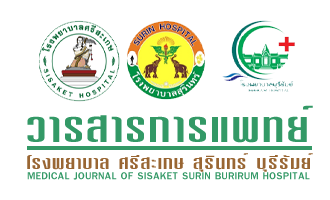การรอดชีวิตของผู้ป่วยมะเร็งรังไข่ที่กลับเป็นซ้ำที่ได้รับการรักษา โดยยาเคมีบำบัดกลุ่ม
Main Article Content
บทคัดย่อ
จุดประสงค์: เพื่อศึกษาเปรียบเทียบการรอดชีวิตของผู้ป่วยมะเร็งรังไข่กลับเป็นซ้ำที่ได้รับการ รักษาโดยยาเคมีบำบัดกลุ่ม Second-line กับกลุ่มที่ไม่ได้รับยาเคมีบำบัด
วิธีการศึกษา: เป็นการศึกษาข้อมูลย้อนหลังในผู้ป่วยมะเร็งรังไข่กลับเป็นซ้ำจำนวน 99 รายที่เข้า รับการรักษาในโรงพยาบาลจุฬาลงกรณ์ระหว่างปีพุทธศักราช 2538-2543 โดย มีการรักษาด้วยยาเคมีบำบัดกลุ่ม Second-line ในผู้ป่วยจำนวน 48 ราย (กลุ่ม A) เปรียบเทียบกับกลุ่มที่ไม่ได้รับยาเคมีบำบัดจำนวน 51 ราย (กลุ่ม B) มีการบันทึกข้อมูลของการศึกษาของการรักษาเริ่มแรกในเรื่อง อายุ ระยะของโรค ผลทางพยาธิวิทยา และการคงเหลือของเนื้องอกหลังการผ่าดัดครั้งแรก และ ข้อมูลหลังการกลับเป็นซ้ำของมะเร็งรังไข่ได้แก่ น้ำในช่องท้อง ตำแหน่งของ การกระจาย สภาพของผู้ป่วย การรักษาด้วยการผ่าดัด และขนาดของเนื้องอก หลังจากนั้นเปรียบเทียบข้อมูลสองกลุ่มโดยใช้X2 ศึกษาการรอดชีวิดโดยใช้ K apian Meier method และศึกษาปัจจัยที่มีผลต่อโรคด้วย Log rank and Cox regression
ผลการศึกษา: พบว่าข้อมูลเบื้องต้นก่อนการกลับเป็นซ้ำในกลุ่ม A และกลุ่ม B ไม่แตกต่างกัน แต่หลังมีการกลับเป็นซ้ำ พบว่ามีภาวะดื้อต่อ Platinum พบในกลุ่ม A เท่ากับ 31.2% เปรียบเทียบกับกลุ่ม B เท่ากับ7.8%นอกจากนี้ยังพบว่าการรักษาโดย การผ่าตัดหลังการกลับเป็นซ้ำเป็นปัจจัยเดียวที่มีผลต่อการพยากรณ์ของโรค (p=0.0016) ค่ากลางการรอดชีวิตหลังการกลับเป็นซ้ำในกลุ่ม A มากกว่า กลุ่ม B อย่างมีนัยสำคัญทางสถิติ (12 และ3 เดือนตามลำดับ) (p=0.000)
สรุป: การให้ยาเคมีบำบัดชนิด Second-line ในกลุ่มผู้ป่วยมะเร็งรังไข่ที่กลับเป็นซ้ำ สามารถเพิ่มระยะเวลาการรอดชีวิต โดยเฉพาะในกลุ่มที่สามารถทำการผ่าตัดได้
นิยามศัพท์: มะเร็งรังไข่กลับเป็นซ้ำ. ยาเคมีบำบัดกลุ่ม second line, secondary cytoreductive surgery
Article Details
เอกสารอ้างอิง
2. Yancik R. Ovarian cancer. Age contrasts in incidence, histology, disease stage at diagnosis, and mortality. Cancer 1993;71(2 Suppl):517-23.
3. Vogl SE, Pagano M, Kaplan BH, Greenwald E, Arseneau J, Bennett B. Cis-platin based combination chemotherapy for advanced ovarian cancer: High overall response rate with curative potential only in women with small tumor burdens. Cancer 1983;51:2024-30.
4. Hacker NF, Berek JS, Lagasse LD, Neiberg RK, Elashoff RM. Primary cytoreductive surgery for epithelial ovarian cancer. Obstet Gynecol 1983;61:413-20.
5. Delgado G, Oram DH, Petrilli ES. Stage III epithelial ovarian cancer: the role of maximal surgical reduction.Gynecol Oncol 1984;18:293-8.
6. Hainsworth JD, Grosh WW, Burnett LS, Jone HW 3rd, Wolff SN, Greco FA. Advanced ovarian cancer ะ long term results of treatment with intensive cisplatin-based chemotherapy of brief duration. Ann Intern Med 1988;108:165-70.
7. Neijt JP, ten BokkelHuinink WW, van der Burg ME, van Oosterom AT, Willemse PH, Vermorken JB, et al. Long-term survival in ovarian cancer. Mature Data from The Netherlands Joit Study Group for Ovarian Cancer. Eur J Cancer 1991;27:1367-72.
8. Piver MS, Lele SB, Marchetti DL, Baker TR, Emrich LJ, Hartman AB. Surgically documented response to intraperitonealcisplatin, cytarabine, and bleomycin after intravenous cisplatin-based chemotherapy in advanced ovarian adenocarcinoma. J Clin Oncol 1988;6:1679-84.
9. Ozols RF. Update on the management of ovarian cancer. Cancer J 2002; 8 Suppl 1:S22-30.
10. Memarzadeh S, Berek JS. Advances in the management of epithelial ovarian cancer. J Reprod Med 2001;46:621-30.
11. Cannistra SA. Cancer of the ovary. N Engl J Med 1993;329:1550-9.
12. Ozols RF. Treatment of recurrent ovarian cancer: increasing options “recurrent” results. J Clin Oncol 1997;15:2177-80.
13. Bookman MA, Malmstrom H, Bolis G, Gordon A, Lissoni A. Krebs JB, et al. Topotecan for the treatment of advanced epithelial ovarian cancer: an open-label phase II study in patients treated after prior chemotherapy that contained cisplatin or carboplatin and paclitaxel. J Clin Oncol 1998;16:3345-52.
14. Hoskins P, Eisenhauer E, BeareS, Roy M, Drouin P, Stuart G, et al. Randomized phase II study of two schedules of topotecan in previously treated patients with ovarian cancer: a National Cancer Institute of Canada Clinical Trials Group study. J Clin Oncol 1998;16:2233-7.
15. Swisher EM, Mutch DG, Rader JS, Elbendary A, Herzog TJ. Topotecan in platinum- and paclitaxel-resistant ovarian cancer. Gynecol Oncol 1997;66:480-6.
16. ten Bokkel Huinink W, Gore M, Carmichael J, Gordon A, Malfetano J, Hudson I, et al. Topotecan versus paclitaxel for the treatment of recurrent epithelial ovarian cancer. J Clin Oncol 1997;15:2183-93.
17. Rose PG, Blessing JA, Mayer AR, Homesley HD. Prolonged oral etoposide as second-line therapy for platinum-resistant and platinum-sensitive ovarian carcinoma: a Gynecologic Oncology Group study. J Clin Oncol 1998;16:405-10.
18. Manivel JC, Wick MR, Coffin CM, Dehner LP. Immunohistochemistry in the differential diagnosis in the second-look operation for ovarian carcinomas. Int J Gynecol Pathol 1989;8:103-13.
19. Lawton FG, Redman CW, Luesley DM, Chan KK, Blackledge G. Neoadjuvant (cytoreductive) chemotherapy combined with intervention debulking surgery in advanced, unresected epithelial ovarian cancer. Obstet Gynecol 1989;73:61-5.
20. Piccart MJ, Gore M, ten Bokkel Huinink WW, Van Oosterom A, Verweij J, Wanders J, et ฟ. Docetaxel: an active new drug for treatment of advanced epithelial ovarian cancer. J Natl Cancer Inst 1995;87:676-81.
21. Muggia FM, Braly PS, Brady MR, Sutton G, Copeland LJ, Lentz LS, et al. Phase III trial of cisplatin or paclitaxel, versus their combination in suboptimal stage III and IV epithelial ovarian cancer: Gynecologic Oncology Group study #132 [abstract]. Proc Am Soc Clin Oncol 1997;16:1257a.
22. Thigpen JT, Vance RB, Khansur T. Second-line chemotherapy for recurrent carcinoma of the ovary. Cancer 1993; 7 l(4Suppl):1559-64.
23. Alberts DS. Treatment of refractory and recurrent ovarian cancer. Semin Oncol 1999;26(1Suppl 1):8-14.
24. Markman M, Hoskins W. Responses to salvage Chemotherapy in ovarian cancer: a critrical need for precise definitions of the treated population. J Clin Oncol 1992;10:513-4.
25. Sutton GP, Blessing JA, Homesley HD, Berman ML, Malfetano J. Phase II trial of ifosfamide and mesna in advanced ovarian carcinoma: a Gynecologic Oncology Group study. J Clin Oncol 1989;7:1672-6.
26. Manetta A, MacNeill C, Lyter JA, Scheffler B, Podczaski ES, Larson JE, et al. Hexamethylmelamine as a single second-line agent in ovarian cancer. Gynecol Oncol 1990;36:93-6.
27. Vergote I. Himmelmann A, Frankendal B, Scheistroen M. Vlachos K, Trope C. Hexamethylmelamine a second-line therapy in platinum-resistant ovarian cancer. Gynecol Oncol 1992; 47: 282-6.
28. Adams M, A’Hem RP, Calvert AH, Carmichael J, Clark PI, Coleman RE, et al. Chemotherapy for ovarian cancer-a consensus statement on standard practice. Br J Cancer 1998;78:1404-6.
29. Howkins RE. Chemotherapy for ovarian cancer-trials, controversies and funding.Br J Cancer 1998; 78: 1402-3.
30. Ozols RF, Markman M, Thigpen JT, ICON3 and chemotherapy for ovarian cancer. Lancet 2002; 360: 2086-7.
31. Rowinsky EK, Cazenave LA, Donehower RC .Taxol: a novel Investigational antimicrotubule agent. J Natl Cancer Inst 1990;82:1247-59.
32. Thigpen T, Blessing J, Ball H, et al. Phase II trial of taxol as second-line therapy for ovarian carcinoma [abstract]. Proc Am SocClinOncol 1990:19:156.
33. Knopf K, Brown M, Kohn EC, Lack of improvement in survival in patients with relapsed or refractory epithelial ovarian cancer, 1980-1997 [abstract]. Proc Am Soc Clin Oncol 1998;17:359a.


